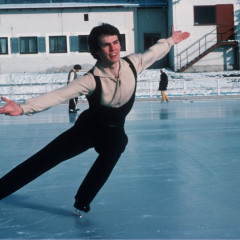Figure skating is undeniably an art form. Casual viewers may be more drawn to the performances of the skaters, rather than the technical aspects of the sport. Yet, past competitions did not encourage men to incorporate dance into their routines. Athleticism was prided above physical lyricism, with skaters presented as traditionally masculine. However, one British skater had different ideas. His name was John Curry. Olympic champion in 1976, Curry defied the strict conventions of the sport and transformed figure skating into the mesmerising performance that we are used to seeing today.
Born in 1949, Birmingham, Curry originally wanted to take ballet lessons, however his father refused. Eventually he was allowed to skate, mainly because it was a sport. Whilst he aimed towards the Olympics, this was a means to an end for Curry. Winning would allow him to realise his dream of merging the expressiveness of dance with skating, creating a theatrical experience. Financial concerns plagued his early years, working in a supermarket to fund his skating, and letters to his friends hinted that he experienced depression. Being told to ‘skate like a man!’ by his trainer must have been incredibly difficult, when the way he moved on the ice was such an important aspect of his self-expression. Curry was right to not abandon his skating style, however.
After the 1973 World Championships, he was approached by sponsor Ed Mosler, who had been watching him for the past three years and liked what he saw. Suddenly, Curry found himself with money and a renowned coach, Carlo Fassi, to aid his career. 1976 was Curry’s year, when he achieved Gold at the European and World Championships. However, it is the Olympics that he will be most remembered for. Flag Bearer for Great Britain, he went on to win the title with an all time high score of 192.74. The judges remarked on his perfect balance between athleticism and artistry. Overshadowing his win, however, was the report that Curry was gay, as he was outed by a German tabloid paper.
Curry did not retreat, confirming that he was gay. He was met with an overwhelming amount of support from England, with letters flooding in, congratulating him on his Olympic victory – notably from the Royal Ballet. He won BBC Sports Personality of the Year, introduced as a man of ‘great social courage’.
After 1976, Curry continued to flourish. Through achieving his Olympic dream, he now had the platform to revolutionise the sport into art on ice. Creative designers and skaters were brought together to build this vision. Performances drew from famous ballets, with stories being told through the skater’s movements in a distinct way that was unique to their performance on ice. Footage is scarce of the company’s performances, but those that stand out are Afternoon of a Fawn, Tango-Tango and Moonskate. They are enchanting; Moonskate encapsulates the ethereal qualities of Curry’s skating perfectly.
By 1978 Curry was living in New York. Here, he found a strong gay community, especially in Fire Island, where he found he could be expressive and open about his sexuality. After taking his company around the world and his ambition to perform at the Metropolitan Opera House in New York realised, Curry grew tired of skating. With his company in debt, he stepped away from the ice. In the late eighties, he revealed he was HIV positive, and in 1994 lost his life to a heart-attack.
Curry’s influence is astounding. During his career he was extremely popular, with sold out tours attended by famous visitors such as Diana Ross. He was an innovator that went beyond the sport of figure skating, pioneering it as a performance art. More recently the documentary ‘The Ice King’ was released. It is a great opportunity to view his captivating performances, and it keeps his legacy alive. Looking at the way male figure skaters perform today, they embody the same expressive movements Curry pioneered. Primarily, he will be remembered for embracing his individuality. In a time where there were few gay men in the public eye, he pushed to perform and live the way he wanted. John Curry was a man persistent in expressing himself.
Link to 'The Ice King' trailer: https://www.youtube.com/watch?v=8pyaMyb2vWM








0 Comments